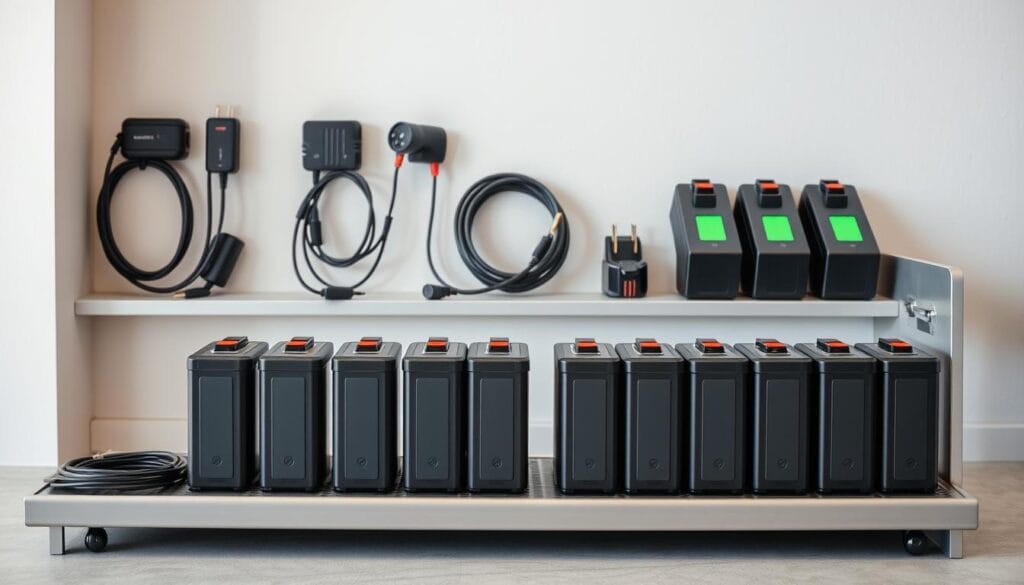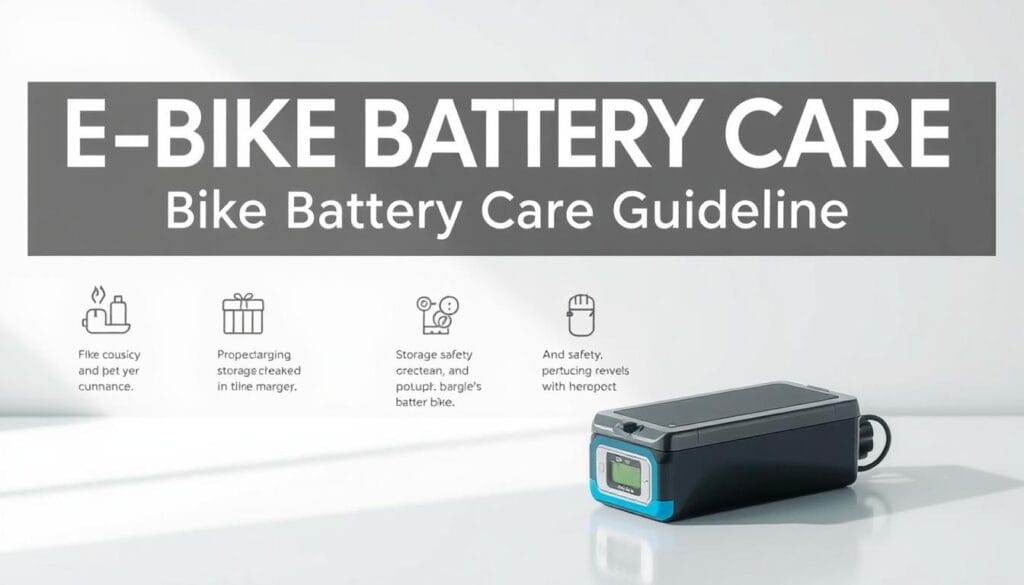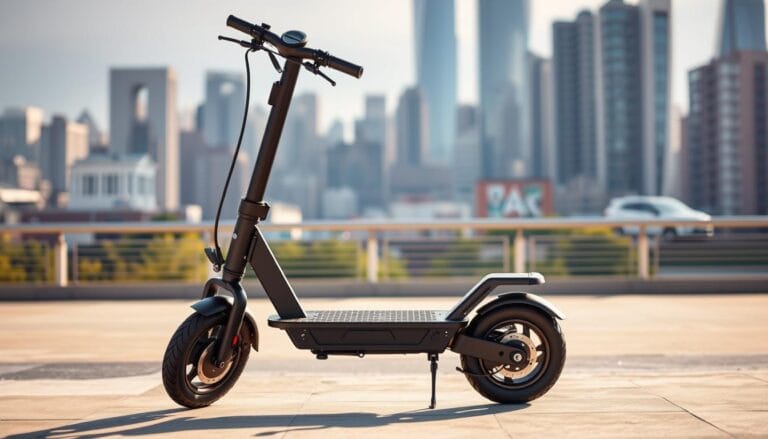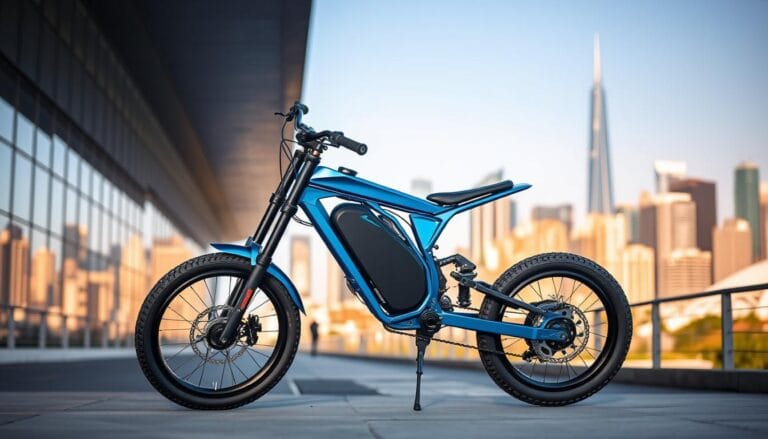E-Bike Battery Care: How to Extend Its Lifespan
Imagine riding down a scenic bike path, feeling the wind in your hair. You’re powered by your e-bike’s battery, moving quietly. This experience relies on your battery’s health.
As an e-bike lover, I’ve found that caring for your battery is key. It’s not just about keeping it running. It’s about keeping your electric ride alive.
Your e-bike’s lithium-ion battery is a big deal. It’s a big investment in green travel. Taking good care of it can make it last longer. This saves you money and keeps your ride in top shape.
Modern e-bike batteries usually last 3-5 years. But with the right care, you can make them last even longer. The trick is to know what your battery needs and how to charge and store it wisely.
Table of Contents
Understanding E-Bike Battery Basics
Electric bicycle power storage is key in modern e-bike tech. Knowing how e-bike batteries work can boost your ride and battery life.
Types of E-Bike Batteries
The e-bike battery world is varied, with several main types:
- Lithium-ion Batteries: The top pick, known for great power and light weight
- Nickel-Metal Hydride (NiMH) Batteries: Older tech with a shorter life
- Lead-acid Batteries: The cheapest but heaviest choice
How E-Bike Batteries Work
Understanding lithium batteries means grasping their energy storage basics. They store energy through chemical reactions, turning it into power for your bike. Most e-bike batteries have 36V to 48V, with 300Wh to 700Wh capacity.
Common Battery Terminology
To grasp battery specs, here are important terms:
- Voltage (V): Shows electrical potential
- Amp-hours (Ah): Shows battery capacity
- Watt-hours (Wh): Shows total energy storage
Lithium-ion batteries last 500-1,000 charging cycles, about 3-5 years with regular use. Knowing these basics helps you choose the right power system for your e-bike.
Importance of Proper Battery Care
Looking after your e-bike battery is key to getting the most out of your ride. With the right care, your battery could last 5-7 years or more. Learning how to extend battery life is a smart move to keep your e-bike running smoothly.
Benefits of Maintaining Your Battery
Spending time on E-Bike Battery Care has many perks:
- Extends battery performance and range
- Prevents unexpected power failures
- Maintains consistent electric assistance
- Reduces long-term replacement costs
Cost Savings on Battery Replacement
Regular battery upkeep can save you money. Most e-bike batteries cost between $400 and $1,000. So, taking good care of it is a wise financial choice.
| Maintenance Level | Battery Lifespan | Estimated Savings |
|---|---|---|
| Poor Maintenance | 3-4 years | $0 |
| Good Maintenance | 5-7 years | $400-$1000 |
By sticking to the right charging and storage tips, you can significantly extend your battery’s useful life. Important steps include keeping the charge between 30-60% when not in use, avoiding full discharge, and keeping it away from extreme temperatures.
Optimal Charging Practices
Charging your e-bike battery right is key to keeping your ride in top shape. Knowing the best ways to charge can make your battery last longer and ensure you have reliable rides.
Recommended Charging Frequency
Charging your e-bike battery needs some planning. Here’s what experts say:
- For regular riders: Charge after every ride
- For occasional riders: Charge when battery drops to 20% or lower
- Aim to keep battery charge between 20% and 80% for optimal performance
Best Charging Techniques
Good care for your lithium-ion battery is more than just plugging in. Here are some key tips:
- Use only the manufacturer-recommended charger
- Charge in a cool, dry environment
- Avoid charging in extreme temperatures
- Aim for a charging time of 3-4 hours
Avoiding Overcharging
Overcharging can harm your e-bike battery’s life. Protect your investment with these tips:
- Unplug the charger once the battery reaches full charge
- Use smart chargers with automatic shut-off features
- Monitor battery temperature during charging
- Avoid leaving the battery plugged in for extended periods
Pro Tip: Most modern e-bike batteries have built-in protection circuits to prevent overcharging, but manual monitoring is still recommended.
By following these charging practices, you can get the most out of your battery. Remember, taking good care of it can make it last 3-5 years or up to 500-1000 charging cycles.
Temperature and Its Effects on Battery Life
When handling lithium batteries, it’s important to watch the temperature. Your e-bike battery works best in certain temperatures. Knowing how temperature affects your battery can help keep it running well longer.
Lithium-ion batteries don’t like extreme temperatures. Most e-bike batteries do best between 20 to 25 degrees Celsius (68 to 77 degrees Fahrenheit). Temperatures outside this range can hurt your battery’s performance and lifespan.
Ideal Operating Temperatures
Your e-bike battery faces different challenges in different temperatures:
- Cold temperatures below 0°C (32°F) can cut battery range by up to 20%
- Extreme heat above 40°C (104°F) speeds up battery wear
- Long exposure to extreme temperatures can damage your battery permanently
Seasonal Storage Tips
Storing your battery right is key, no matter the season. Temperature is even more important when storing.
- Keep batteries at 10-20°C (50-68°F) for best preservation
- Charge batteries to 40-60% for long-term storage
- Avoid direct sunlight or very cold places for storage
How to Protect Your Battery in Extreme Weather
To keep your e-bike battery safe from extreme temperatures, you need to act. Here are some tips for handling lithium batteries in tough weather:
- Use insulated covers in cold or hot weather
- Keep batteries indoors in extreme weather
- Let batteries warm up to room temperature before charging
By following these temperature tips, you can make your e-bike battery last longer and perform better.
Regular Maintenance Tips
Proper lithium-ion battery maintenance is key for your electric bike’s best performance and life. Regular care can stop problems before they start and make your battery last longer.
Cleaning Your Battery Properly
Keeping your e-bike battery clean is vital for its health. Here’s how to do it right:
- Use a soft, dry cloth to wipe down the battery exterior
- Remove the battery before cleaning
- Avoid using water or liquid cleaners directly on electrical components
- Check for any visible dirt or corrosion on battery contacts
Inspecting for Damage
Regular checks can spot issues early. Watch out for these signs:
| Inspection Area | What to Look For |
|---|---|
| Battery Exterior | Cracks, dents, or unusual swelling |
| Battery Contacts | Corrosion or oxidation |
| Battery Performance | Reduced range or unexpected power drops |
When to Seek Professional Help
Some battery problems need a pro’s touch. Don’t try to fix complex issues yourself. Get help if you see:
- Significant performance drop
- Physical damage to the battery
- Electrical issues or charging problems
- Battery swelling or extreme heat
Most e-bike batteries last 3 to 5 years with good care. By following these tips, you can make your battery last longer and perform better.
Battery Storage Guidelines
Storing your electric bicycle’s battery right is key to keeping it in top shape when not in use. Knowing the best methods can make your battery last longer and work better.

Looking after lithium batteries means paying attention to a few important things. How you store your e-bike battery can greatly affect its performance and life.
Ideal Storage Conditions
Creating the best storage spot for your e-bike battery involves several things:
- Keep the temperature steady between 10°C and 25°C (50°F to 77°F)
- Find a dry spot, away from direct sunlight
- Keep the battery away from extreme temperatures
- Store it in a clean, dust-free place
Long-Term Storage Tips
“Proper battery storage can extend your e-bike battery’s life by up to 30%.”
For long-term storage, follow these key tips:
- Charge the battery to 40-60% before storing it
- Check the charge every three months
- Avoid letting the battery go completely dead
- Use methods approved by the manufacturer
Maintaining Charge Levels During Storage
It’s crucial to keep your battery at the right charge level. Never store a fully charged or completely drained battery. Try to keep it between 30-70% charged to avoid losing capacity.
By sticking to these tips, you’ll get the most out of your e-bike battery’s performance and life.
Signs Your Battery Needs Replacement
Looking after your e-bike battery is key to keeping your electric bike running well. Knowing when to swap out your battery can save you time, money, and keep you safe.
Warning Signs to Watch For
Watch out for these signs that your e-bike battery might be getting old:
- Significant reduction in riding range
- Longer charging times than usual
- Inconsistent power output
- Physical damage or swelling of the battery
- Sudden unexpected shutdowns during rides
Testing Battery Health
Keeping your battery in top shape is important. Here are ways to check its health:
- Track mileage and compare current range to original performance
- Use manufacturer-provided diagnostic tools
- Consult professional e-bike technicians for detailed assessment
- Check voltage using a multimeter
Making the Replacement Decision
When deciding if you need a new battery, think about these points:
- Battery age (typical lifespan is 2-5 years)
- Number of charge cycles completed
- Performance degradation
- Cost of replacement versus current battery efficiency
- Environmental impact of battery disposal
Proactive E-Bike Battery Care can help you get the most out of your battery. It also helps you make smart choices when it’s time for a new one.
Understanding Your E-Bike Manufacturer’s Guidelines

Knowing how to care for your e-bike battery is key to keeping your bike running well. Manufacturers give detailed advice on how to handle your battery right. This advice is crucial for keeping your electric bike in top shape.
Manufacturer Recommendations: Your Battery’s Roadmap
Every e-bike brand has its own tips for battery care. Important advice usually includes:
- Using only manufacturer-approved chargers
- Maintaining optimal charging levels between 20-80%
- Avoiding extreme temperature exposure
- Storing batteries in recommended conditions
Warranty Considerations: Protecting Your Investment
Your e-bike’s warranty can be affected by how you care for the battery. Improper charging or ignoring the manufacturer’s advice might void your warranty. Always keep records of your battery care and save the original instructions.
Common Mistakes to Avoid
Many riders make mistakes that harm their battery’s life:
- Charging below 20% or above 80%
- Exposing batteries to extreme temperatures
- Using non-approved charging equipment
- Neglecting regular battery inspections
Pro tip: Always consult your specific manufacturer’s manual for the most accurate battery care instructions.
By following these tips, you’ll get the most out of your e-bike battery. You’ll also protect your warranty and make your battery last longer.
Environmental Impact of E-Bike Batteries
E-bikes are a green way to travel, cutting down on carbon emissions a lot. It’s important to know how e-bike batteries affect the environment. This knowledge helps us take care of our planet.
Recycling Batteries Properly
Recycling e-bike batteries is key to protecting our planet. Each battery has materials that can be used again. Here’s how to recycle your e-bike battery right:
- Find places that recycle batteries
- Make sure batteries are empty before recycling
- Use tape to cover battery terminals to avoid short circuits
- Don’t throw batteries away with regular trash
Environmental Benefits of E-Bikes
Traveling long distances on an e-bike is good for the environment. E-bikes are much better than cars when it comes to emissions. Cars are a big part of why we have so much pollution, but e-bikes can cut emissions by up to 90%.
| Transportation Method | Annual CO2 Emissions | Energy Efficiency |
|---|---|---|
| Conventional Car | 5-9 tonnes | Low |
| E-Bike | 0.5-1 tonnes | High |
Reducing Your Carbon Footprint
By recycling e-bike batteries and using e-bikes, you help the environment a lot. Each charge uses a small amount of energy, making recycling very important. It helps make cities cleaner and greener.
Upgrading Your E-Bike Battery
Upgrading your e-bike battery can change how you ride. Look for options that boost your bike’s range and performance.
Upgrading your battery can make a big difference. The right choice can unlock new riding possibilities and extend your bike’s life.
Key Considerations for Battery Upgrades
- Evaluate your current battery’s performance and range
- Assess your typical riding distance and terrain
- Check compatibility with your e-bike’s existing systems
- Consider budget and long-term investment
Compatibility Challenges
Not all batteries fit all e-bikes. Before upgrading, check a few key things:
- Voltage matching with your e-bike’s controller
- Physical dimensions and mounting compatibility
- Connector type and electrical specifications
- Manufacturer warranty considerations
Performance Enhancement Strategies
Upgrading your battery can offer big benefits. A bigger 17Ah battery can take you up to 100km, unlike smaller 11Ah batteries that only go 30km. When choosing an upgrade, look for:
- Increased range capabilities
- Improved power output
- Better energy efficiency
- Potential weight reduction
Keep your new battery charged between 20% and 80% to keep it running well. Taking good care of it will make your investment last longer.
The Future of E-Bike Batteries
Electric bicycle power storage is getting a big boost, exciting e-bike fans. New tech is changing how we travel long distances on e-bikes. It’s making batteries better and more durable.
Solid-state battery tech is a big leap forward. These batteries pack more power, charge faster, and are safer than old lithium-ion ones. Brands like Trek and Electra are working on better battery systems. They aim to control temperature and boost battery performance.
The future of e-bike batteries is looking up. Experts say we’ll see bigger batteries, faster charging, and longer rides. You’ll get batteries that last longer and work better, making long trips easier than ever.
Now, making batteries better for the planet is a big goal. New tech wants to make batteries that are greener, easier to recycle, and have less harm to the environment. As prices fall and tech gets better, e-bike batteries will be more affordable and reliable for everyone in the U.S.







